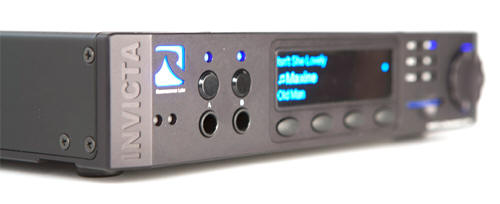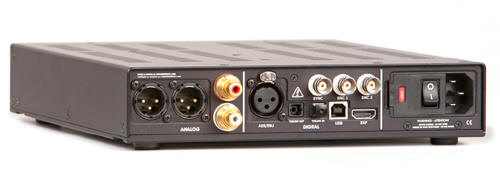|
|
You are reading the older HTML site
Positive Feedback ISSUE 65
resonessence labs Invicta DSD-Capable DAC - Out of the Box as reviewed by Lynn Olson
Let's cut to the chase: the Invicta is one of the three best experiences I've heard with DSD sources. Considering that the other two were at David Robinson's place, and the Sonoma system at Super Audio Center in Boulder, Colorado, that's pretty good company. For those who don't know about the sonics of DSD downloads, think of it as having your own Studer or Ampex professional tape deck in your living room, with 2nd or 3rd-generation copies of the 2-track mastertape. Not exactly the same, but pretty close, and not the same as LP playback or most PCM digital. The colorations of SACD/DSD are not the same as good ol' PCM. We all know what bad PCM sounds like: coarse, gritty, harsh, and 2-dimensional. Bad SACD/DSD sounds completely different: dull, flat, and syrupy—almost a cartoon of analog. As DSD gets better, it sounds quicker, more snappy, and tone colors get more vivid. At the highest level of PCM and DSD, they start to converge, and sound more like a top-quality master-tape, or at the ultimate level, a direct mike-feed. Like the performers are right in the room with you, with no electronics at all. The Invicta is at the top level of DSD; close to a mastertape—maybe just a little sweeter than the real thing, but pretty close, and much more vivid than typical delta-sigma digital, which I find pretty flat-sounding. I'm guessing the sophisticated noise-shaping algorithms that ESS uses for PCM decoding have been tweaked and supercharged for DSD decoding. The Invicta sounds like a studio decoder, not a consumer product. If you've only heard your SACD collection through one-box players with generic delta-sigma converters, you're in for a treat. The biggest problem with SACD, and the DSD content on the disc, has been the sound trapped in the one-box player. I've been through at least three of these overpriced things, and finally got tired of buying and selling them. One of the reasons that SACD eventually failed was the extremely restrictive nature of the medium: no standardized interface between transport and external DAC, no way to copy a disc to a computer (except for an absurd method using an old, non-updated Playstation 3 game console), and no way to burn a disc of your own. All of these limitations were intentional on the part of Sony; part of the Hollywood paranoia about copying high-resolution music and video. At the same time, hundred of millions of people were cheerfully copying terabytes of MP3's off the Internet. That's Hollywood for you: real deep thinkers. The side effect of these limitations was to trap audiophiles—the primary market for SACD's—into buying one-box players. Well, I have a small collection of SACD's, and I know people (like David) who have very large collections. Part of the reason I never got very far into the medium was the rotation of different SACD or Universal (SACD & DVD-A) players. All of them were overpriced, and all of them underperformed. After my fourth one, I relegated it to transport duty, where it performs exceptionally well (a modified Denon DVD2900). But the only digital output it has is S/PDIF coax, which supports 44.1/16 Red Book CD's and 96/24 DVD-A's, but so sorry, no DSD output for you. When a SACD is played, the digital output is downsampled to 44.1/16. Thank you very much, Sony. That really adds a lot of value to my SACD collection.
Like many other audiophiles, I gave up on SACD and DSD. The analog sound quality of the heavily modified player is far below my own DAC (a Monarchy N24 using the Burr-Brown PCM-1704 converter, passive I/V conversion, and vacuum-tube analog amplification). I've heard plenty of other one-box players; same story. True, there are $10,000-and-up one-box players, but having been burned not once, not twice, but three times, do you think I'm going there? No. But David got me going again—particularly after hearing his setup when I visited Portland last fall. Well, OK, downloads sound mighty fine. Really good, in fact. I'm not a huge fan of computer audio, but what the heck, I've got a MacBook Pro with dual-core i7 processors, 8 GB of memory, and a 750 GB hard disk. The machine is usually dedicated to travel and boring jobs like measuring loudspeakers; might as well get a little more use out of it. I picked up a copy of Pure Music, a reasonably priced software suite, and surprise, surprise, it plays 64 fs (same as SACD) and 128 fs DSD through the USB 2.0 and Firewire/IEEE 1394 ports. Now what? Might as well audition the new crop of USB-input DACs that also have DSD playback capability. I've had rather mixed results with USB-to-S/PDIF converters, and besides, there's that no-DSD-over-S/PDIF limitation all over again. Most of the DACs I've auditioned that use delta-sigma converters (the most popular type) have been rather disappointing. At the 2011 Rocky Mountain Audio Festival, I went to a presentation by Martin Mallinson, the product manager of the ESS Sabre 9018, and was surprised by all the research ESS had done on correcting the subtle and hard-to-find problems of delta-sigma DACs. Designing noise-shaping systems that are free of idle tones and noise-floor modulation is not trivial—and it is these artifacts that are largely responsible for the sound of delta-sigma DACs. Time moves on: Mark Mallinson (Martin's brother) formed Resonessence, an audio company in Kelowna, Canada, around the ESS 9018 chip his brother's team designed. Well, that's interesting. Resonessence is certainly in a good position to design around it—in a way, similar to the Microsoft/Intel relationship. The first product was the Resonessence Invicta. Because it is firmware-programmed by the SD card on the front panel, it can—and has—been substantially upgraded during the year or so it's been on the market. And the latest upgrade (you knew this was going somewhere, didn't you?) is 4.0.1, which supports DSD. The SD card slot on the front panel? The DAC can play audio right off the card. Look ma, no computer! The Invicta supports WAV (Windows), AIFF (Apple), FLAC (everything), and now, DFF files. Neat! Playing an SD card is certainly an elegant way to bypass all the worries about USB-transmitted jitter from the computer (yes, I've read about different platforms… PC, Mac, Linux, laptop, fullsize, etc. … sounding different from each other). Sonic differences between the SD card and the computer? Hmmm … well, on 88.2, 96, and 192 kHz PCM material, I didn't hear too much difference, but it seemed like DSD definitely sounded more like the original recording studio when playing tracks off the card. But Pure Music from the MacBook Pro sounded pretty good as well, and offered the option of real-time conversion to 88.2/24 and 176.4/24 if I was curious to hear how it sounded in PCM. Uh, not as good. Converting DSD to PCM definitely alters the character, and oddly, the imaging of the mix, not something I'd expect. What about double-rate (128 fs) DSD? I couldn't get it work, but that could be the files, Pure Music, or just another firmware release away. The sound quality with 64 fs DSD, though, is stunning: true studio-quality DSD, no apologies, and some of the best sound I've ever heard from my system. The sound is really luscious, DSD at its best, and miles away from those one-box players. My wish list? Believe it or not, there's an HDMI port on the back! Unfortunately, all it does is send a track-list image to an external HDMI display, useful for SD playback, but the front panel already displays the current track, name, and playing time. What would really make the HDMI port useful would be HDMI input; it's not widely known, but there is a DSD-over-HDMI protocol. I know it's real; my Marantz AV8003 pre-pro supports the standard, as well as all of the OPPO models, Marantz, and the high-end Denon Blu-Ray players. If the HDMI port could be re-purposed as an input, yes, playback from a SACD disc would be possible, not just DSD downloads! That would greatly extend the usefulness of the Invicta, making it a true universal DAC that supports all formats – USB 2.0 from a computer, the SD card, and all formats of high-resolution audio from a Blu-Ray player (BD players can convert the encoded audio from DTS-Master, and Dolby Studio, to standard high-res PCM streams over HDMI). I admit DSD-over-HDMI is kind of an odd duck; SACD's were going away at the same time that Blu-Ray players, with their HDMI ports, were coming in. But Blu-Ray is a Sony standard, after all, so I'd imagine that at least some of the Sony players offer SACD playback. The OPPO players are probably a better choice. But that prompts a question: why buy the Invicta if the top-of-the-line OPPO has the same ESS Sabre 9018 chipset? Well, part of the appeal of the Invicta is the firmware-upgradeability, as well as a first-class analog section, free of all the noise of a mechanical transport. Although the 9018 is ESS' highest-performance converter, the tradeoff is increased sensitivity to power-supply noise, jitter from clocks, and circuit-board layout: this is why DACs based on the 9018 actually sound quite different from each other. The reports you've heard of the ESS 9018 sounding brash or harsh is what the 9018 sounds like with a sub-optimal implementation; it is not the actual sound of the 9018. The Invicta makes the point with beautifully smooth, silky, and colorful sound. I might be going out on a limb here, but if the 9018 is the best of the delta-sigma converters (and I think it is), the Resonessence Invicta is the best of the DACs that use the 9018. The sound with PCM material? Well, I still (slightly) prefer the TI/Burr-Brown 1704, but the difference is marginal. If you walked out of the room and walked back in again, you might not notice, it's that small. The best-sounding mode seems to be setting Pure Music to upsample Red Book to 176.4/24, but you can upsample in the Invicta as well; it just sounds a bit different, and you get a choice of no less than seven filter modes (the default Linear Phase Apodizing filter sounds the best, although the Minimum Phase IIR filter is a good alternative). The S/PDIF input sounds pretty good as well; on many discs, for reasons I don't understand, the Denon transport sounds better than the MacBook Pro computer. If you're worried about jitter, well, there's always the SD card. It takes only a few minutes to copy your favorite tracks to the card and insert it into the Invicta's front panel (although I always like to be safe and power-down the DAC before inserting the card). If you're already downloading DSD files, do yourself a favor and audition the Invicta on a good system. If you haven't tried the download/computer audio thing, listen to a few DSD tracks on the Invicta. Unlike most USB DACs, the computer attached to your hi-fi is optional; there's plenty of room on SD cards, and the audiophile USB cable/jitter demon is banished for good. The sound? Studio-quality snap, dynamics, spaciousness, and most all, vivid tone colors; all on a SD card the size of postage stamp. Lynn Olson
Resonessence Invicta DSD-capable DAC
Resonessence |








